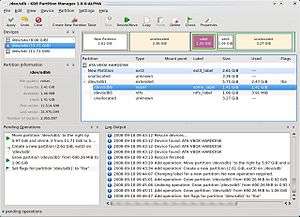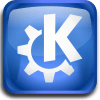KDE Partition Manager
|
| |
|
Screenshot of KDE Partition Manager 1.0.0alpha1 | |
| Original author(s) | Volker Lanz |
|---|---|
| Developer(s) | Andrius Štikonas |
| Initial release | 1.0.0alpha1 (18 September 2008) |
| Stable release |
2.2.1
/ July 6, 2016 |
| Development status | Active |
| Written in | C++ (Qt) |
| Operating system | Cross-platform |
| Available in | Multilingual |
| Type | Partition editor |
| License | GNU GPLv3[1] |
| Website | KDE Partition Manager website |
KDE Partition Manager is a disk partitioning application originally written by Volker Lanz for the KDE Platform. It was first released for KDE SC 4.1 and is released independently of the central KDE release cycle. After the death of Volker Lanz in April 2014,[2] Andrius Štikonas continued the development and took over as the maintainer.
It is used for creating, deleting, resizing, moving, checking and copying partitions, and the file systems on them. This is useful for creating space for new operating systems, reorganizing disk usage, copying data residing on hard disks and mirroring one partition with another (disk imaging). Additionally, KDE Partition Manager can back up file systems to files and restore such backups.
It uses libparted to detect and manipulate devices and partition tables while several (optional) file system tools provide support for file systems not included in libparted. These optional packages will be detected at runtime and do not require a rebuild of KDE Partition Manager.
As is the case with most KDE applications, KDE Partition Manager is written in the C++ programming language and uses the Qt GUI toolkit. Released under the GNU General Public License, KDE Partition Manager is free software.
Release history
| Colour | Meaning |
|---|---|
| Red | Release no longer supported |
| Green | Release still supported |
| Blue | Future release |
| Major Version | Minor Version | Release date | Notes |
|---|---|---|---|
| 1.0 | 1.0.0alpha1 | 18 September 2008[3] | Initial release. |
| 1.0 | 1.0.0alpha2 | 24 September 2008 | Important bugs fixed. |
| 1.0 | 1.0.0beta1a | 13 January 2009 | Crashes and bugs fixed, ext4 support. |
| 1.0 | 1.0.0beta2 | 30 April 2009 | Bugs fixed. Introduces the KCModule. |
| 1.0 | 1.0.0beta3 | 4 June 2009 | Bugs fixed. Speed and usability improvements. |
| 1.0 | 1.0.0rc1 | 3 August 2009 | Bugs fixed. |
| 1.0 | 1.0.0 | 18 August 2009 | First stable |
| 1.0 | 1.0.1 | 9 January 2010 | Bugs fixed. |
| 1.0 | 1.0.2 | 24 April 2010 | Bugs fixed. Usability improvement. |
| 1.0 | 1.0.3 | 1 September 2010 | Bugs fixed. Usability improvements. |
| 1.1 | 1.1.0 | 10 July 2014[4] | New features, support for 4096 byte sectors, Btrfs, GPT, exFAT, NILFS 2, and more. First release by Andrius Štikonas. |
| 1.1 | 1.1.1 | 15 February 2015 | Bugs fixed. |
| 1.2 | 1.2.0 | 15 February 2015[5] | New features. Ported to KDE Frameworks 5. Switched license to GPLv3+.[6] |
| 1.2 | 1.2.1 | 17 February 2015 | Bug fixed. |
| 2.0 | 2.0.0 | 15 January 2016 | Splitting user interface and partitioning library. Bugs fixed. |
| 2.0 | 2.0.3 | 24 February 2016 | Bugs fixed. |
| 2.1 | 2.1.0 | 11 March 2016 | Minimal support for F2FS. |
| 2.2 | 2.2.1 | 27 May 2016 | Support for LUKS.[7] |
| 3.0 | 3.0.0 | Support for LVM. | |
See also
References
- ↑ "Use GPLv3 copyright notices". Retrieved 2015-08-03.
- ↑ "KDE Software Compilation 4.14". Retrieved 2015-08-03.
- ↑ "KDE Partition Manager 1.0.0alpha1 release notes". Retrieved 2009-07-16.
- ↑ "KDE Partition Manager 1.1.0 Release". Retrieved 2014-08-23.
- ↑ "KDE Partition Managers 1.1.1 and 1.2.1". Retrieved 2015-08-03.
- ↑ "Switch license to GPLv3+". Retrieved 2015-08-03.
- ↑ "LUKS partition support in KDE Partition Manager". Retrieved 2016-05-01.
External links
- KDE Partition Manager website
- KDE Partition Manager at KDE Projects
- The KDE Partition Manager Handbook
- KDE Partition Manager on kde-apps.org

